TESLA-E is a personal project by David Dugast for Tesla, Inc., a California-based electric vehicle and clean energy company headquartered in Austin. Tesla designs and manufactures electric vehicles, battery energy storage systems ranging from home to grid-scale, solar panels and solar roof tiles, and related products and services. With a market capitalization of nearly $1 trillion, Tesla is one of the world's most valuable companies and the world's most valuable automaker.
TESLA-E: Introduction

He wanted to build a single-seater that could be driven on the road and on the track for his personal Tesla project. With this in mind, he designed something sporty but not as extreme as a race car. David wanted to give it a curvy, radical appearance by borrowing styling elements from the Cybertruck but combining them with the opposite style of Tesla's production cars. For him, the efficiency of a design that goes to the essentials is what defines this brand, rather than the style.
TESLA-E: Exterior Design

He worked the exterior like an aeroplane fuselage, with very thin sidewalls to give the illusion of lightness. The back end is extremely short, and the car is propelled forward like a hawk swooping on its prey. To amplify this effect, he has suspended the headlights forward. He wanted to keep the shape simple, without too many aerodynamic appendages that would complicate an already radical vehicle.
Details are very important in this car, and he spent a lot of time choosing and emphasising them, such as the illuminated suspension wishbones or the design of the rims, which are made up of several parts, such as a multitude of blades and polycarbonate protection. Small details from the racing world, such as the pilot light in the back, were added to immerse the user in a one-of-a-kind experience.
TESLA-E: Interior Design


The cockpit of the vehicle is also very simple. He wanted to make the bucket seat as comfortable and spacious as possible for a full driving experience. The steering wheel column splits in two and connects to each side of the capsule. It also incorporates the cabin ventilation system. The steering wheel has an integrated screen in the centre that also serves as a connection to the rim. There are controllers on both sides of the steering wheel. The pedal is at the front, and two backlit blades act as a third brake light behind the seat's headrest.
The interior is overhung by a large glass surface, which was inspired by the aviation industry and the cockpit design of a fighter jet. The cockpit's opening is another nod to this world. He had a lot of fun working on this project because it gave him the opportunity to experiment with Blender, as all of the modelling and staging was done with this software.
About Designer
David Dugast, a French automotive designer, is 26 years old. Between 2013 and 2018, he attended the Strate Design School. He learned to be an industrial designer over the course of five years, with the first two years focused on design fundamentals before specialising in automotive design. After graduating, he moved to England in early 2019, where he began working for Tata in Coventry. He had the opportunity to work on the SIERRA concept car, which allowed him to acquire skills and see a project through to completion quickly.
He relocated to London to work for SAIC a year later. He has worked as an interior designer in the advanced studio for two years and now he is associated with Nissan Design Europe. In his design approach, he always tries to simplify as much as possible while maintaining solid elements that define his theme. Instead of impact and visual shock, he seeks elegance and timelessness. Being fresh and surprising while remaining classic is a difficult task, but it's the type of challenge he enjoys and pushes him to do better.











